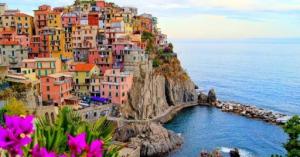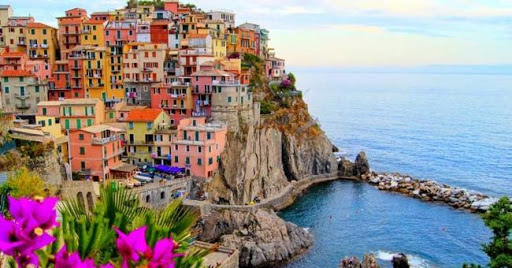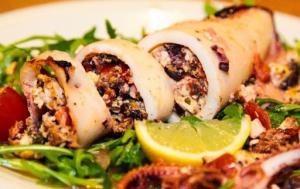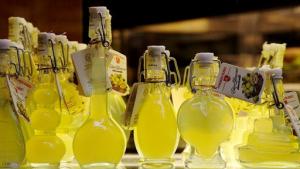Campania is an Italian region located on the very coast of the Tyrrhenian Sea. It is therefore one of the places in Italy where tourism is particularly well developed. The area is rich in archeological treasures such as the ancient Roman town of Pompeii, immersed by the Vesuvius volcano in the 1st century A.D. In fact, Vesuvius still remains an active volcano to the present day, just like the crater Solfatara in the Naples region, whose name means „land of sulfur“.
Volcanoes heat the soil under Campania and this contributes to its beneficial properties. Campania is also famous for its architectural sights – concentrated mostly in its capital Naples. In addition, the region has incredibly beautiful natural landscapes – Amalfi sea resort and Capri island are among the most picturesque places in the country.
The region of Campania is also emblematic in terms of culinary art
Fast food culture is very well developed here. You can enjoy all kinds of food on the streets of Naples and of the other towns of Campania – baked, fried and grilled. The handmade foods offered directly on the street is the most preferred. Cusine of Campania includes a wide range of cheap and affordable fresh products such as seasonal vegetables and pulse. For example, the beans from Alife, Controne and Acerra is great.
But for sure the most famous Italian dish is the pizza – and it was born precisely in the capital of Campania. Pizza „Margherita“ has become a symbol of the region. It was invented specifically for the visit of the Italian queen Margherita of Savoy in Naples, and the colors of the pizza correspond to these of the country’s flag:
- Red of tomato
- White of mozzarella
- Green of basil
Another famous Neapolitan pizza is calzone fritto – closed pizza with ricotta filling, tomatoes, mozzarella, pepper and other ingredients.
The real authentic Neapolitan pizza has a very thin crust. In fact, pizzas in Naples are seasoned with the most delicious buffalo mozzarella in the world– in Italian „mozzarella di bufala“. The first buffalos have arrived in the country around the XII century. Nowadays, the vast majority of these animals is concentrated in Campania, mostly in the provinces of Caserta and Salerno.
The very word mozzarella comes from mozza – the Neapolitan dialectal pronunciation of the verb mozzare, which means „cut“. This name comes from the way of preparation of the mozzarella, where the cheese pieces are cut before being shaped as the well-known rounds. It is consumed throughout the year but mostly in summer.
It is ideal combined with tomatoes – in the form of caprese salad, seasoned with basil, and it also goes well with all other basic foods you can think of. Since 1996, mozzarella di bufala campania, which is characteristic of the region, has the statute of protected geographical indication (PGI), which means that it can be produced and processed only there.
Quality buffalo mozzarella has a pearl color, its surface is smooth, and it brings the smell of the milk from which it is made. Its acidity is also noticeable, as well as the slight resistance of the pieces while chewing. Do not forget that when consumed fresh, the real mozzarella spoils very quickly, literally for days.
The preparation of the traditional mozzarella requires between 16 and 20 hours of work and the masters making this cheese are called cazaro. Mozzarella cheese does not tolerate cold. If the temperature at the place where we intend to consume it is below 20 degrees, it is good to pour warm water on the cheese for a few minutes before we open the package.
Caprese Bruschetta
Perhaps one of the easiest and at the same time typical dishes in the cuisine of Campania is the so-called caprese bruschetta, which is prepared with mozzarella cheese, tomatoes, olive oil, basil and oregano, and it can serve as the ideal appetizer for wine. But the truth is that Naples and Campania love everything „caprese“. With this garnish can be prepared the typical Italian potato gnocchi.
But Campania is not only known for its mozzarella. There are a number of cheeses in this region that can satisfy even the most pretentious tastes – for example, scamorza, cacho cavallo, as well as provolone, although it is more closely related to the regions of Veneto and Lombardy .
Campania is also popular with some wine varieties. The Aglianico variety is known as the „Greek wine“, because in the past it was transported to southern Italy from Ancient Greece. Although it is not only found here, it is in this region that Aglianico has reached the highest heights in terms of quality.
Wonderful white wine in Campania is produced from the Falanghina variety – as this wine is recommended for combination mainly with pasta and fish, and it is great for the summer season. Perhaps the strangest name for grapes is lacryma Cristi del Vesuvio – in literal translation: „the tears of Christ at Vesuvius“–this is not the name of a specific variety, but it means white, red and pink grape colonies from the slopes of the volcano Vesuvius that is close to Naples. For example, here is a small amount of grapes from the variety Greco di Tufo.
It is believed that God once cried for the sins committed by humans under the influence of the Devil, and the place where his tears fell, in the foot of Vesuvius, turned into beautiful vineyrds with inncredible grapes of different varieties.
At the same time, Greco di Tufo has PGI status and also originates from Ancient Greece, and it is believed to be the oldest wine variety in Campania. Red wine is usually a mixture of the grape varieties Piedirosso, Sciascinoso and Aglianico, and the white wines of the Coda di Volpe, Falanghina and verdeca. Although located to the south, the volcanic island of Ischia, adjacent to Campania, is also famous for its wonderful grape varieties and wines.
Naturally, Campania also has its emblematic pasta
This pasta is the so-called fusilli cellentani – macaroni pasta made from wheat, olive oil and water, usually homemade in the region of Cilento – a town in the province of Salerno in Campania. These fusilli can be combined with meat or other aromatic sauce.
Because of its geographic location on the seashore, Campania is also characteristic of its fish dishes. Fresh seafood is consumed as an appetizer. Even on the street you can order a plate of fried fish and seafood, called frito di pesce. Marine products can often be found in soups, stews, as well as in macaroni products.
For example, the dish fagiole e cozze (literally beans and mussels) is something like the Neapolitan version of the Venetian pasta with beans. Here, in unison with the specifics of the region, pork meat is replaced with mussels, and the vegetables – with tomato and red hot pepper. Especially very exotic in terms of taste and looks, is the octopus served in tomato sauce with hot peppers and olive oil, called polpo affogato.
Salty dried cod can be prepared with tomatoes, raisins, olives, capers and cedar nuts – baccala alla Neapolitana. Also a great choice is the zuppa di cozze (soup of mussels) with curry, hot peppers, tomatoes, white wine and parsley. The mussels can also be cooked in their own sauce, and we can season them with parsley, lemon and black pepper – this delicious dish is called impepata di cozze.
Another famous delicacy are the Sorento squids, named after the Sorento province of Campania. The squids are stuffed with cheese and served in tomato sauce. The cheeses, which are most often used for the preparation of Sorento squids are Parmigiano – reggiano and mozzarella.
Residents of Campania also like meat dishes. Braccioli – typical Italian dish, have their own version in the region. Braccioli in Campania, usually made from beef meat, can be prepapred, for example, with tomato sauce. Braccioli can also be consumed with pasta.
The pork meat has found its place also in the cuisine of Campania
Spezzatino is prepared with pork meat – these are bites with aromatic sauce. But local people also like more exotic meats – another recipe that is typical of the Neapolitan region is a baby goat stewed in lemon and peas. Also typical of Campania is the Ischia rabbit – coniglio all’ischitana. According to the local recipe, the rabbit is cooked with tomatoes and seasoned with rosemary and, of course, basil.
Under the influence of the French culinary tradition in Naples comes the chicken dish called sartù (with accent on u). It is something like rice baked pudding, with various vegetables such as mushrooms and peas, as well as mozzarella, sometimes béchamel sauce. The recipe also has a vegetarian version that is prepared with eggplants, zucchini, carrots and other greens.
Agricultural lands of Campania
Campania is rich in high quality meat and fresh seafood from the ports, Campania is also famous for its rich agricultural lands. The residents of Campania, before turning into fans of macaroni products somewhere in the XVIII century, were known as „leaf eaters“. When we say„leaves“we mean chicory, escarole and broccoli that have been consumed massively in the region, as well as throughout Italy, before America was discovered. Nowadays, the typical vegetables of the region, especially of the Salerno province, for example, are the friarielli – delicate variety of broccoli with bitter vein.
To the present day, vegetables and fruits, whether fresh or cooked, are a must in the local cuisine of Campania. They are so delicious because they grow on the fertile soils, warmed by the active volcanoes. Eggplants are highly appreciated and used in the local culinary. They appeared in the culinary tradition of the region at the end of XVII century along with the peppers (tomatoes came even later).
In almost every home in Campania you can try marinated eggplants in butter, but they are most typical of the area around the Salerno province, and the very recipe for it is very old and is passed on from generation to generation. Eggplants are prepared in the form of canned food with the help of a brine of white wine vinegar, water, olive oil, salt, garlic and, if we like spicy taste, hot peppers.
So the canned eggplants can be consumed directly from the jar or they can be added to meats or toasted bread with some cheese. Other vegetables are sometimes prepared in the same way in the region of Campania, for example, zucchini.
Also typical of the region of Campania is the recipe for eggplants with eggs, buffalo mozzarella, parmigiano-reggiano cheese and tomato sauce, seasoned with basil and black pepper. The dish is similar to the Bulgarian mish-mash meal, but it is prepared in the oven and with eggplants instead of peppers. It is considered that the recipe comes from Campania, although its origin is also associated with Sicilia.
Among the most developed fruit crops in Campania are peaches, strawberries – especially from the Afragola city in Naples, apricots that grow mostly on the slopes of Vesuvius and in the Sele valley, as well as the apples Anurche from Marano di Napoli. The Sorento province is famous for its huge walnuts, and Avelino and Benevento are big producers of hazelnuts. All of these products, in addition to the fact that they stimulate local trade, also influence the culinary traditions of the region.
The region of Campania is also known for its local lemons – the variety from the town of Amalfi Sfusato (sfusato di Amalfi or sfusato amalfitano). In the past, Amalfi was an independent republic that traded with the Middle East. So the first lemons arrived in Italy, but they were small and practically they were not fit for consumption. Over time, local agronomists crossed these lemons with bitter oranges. This is how the „nostrato“variety appeared, which is a direct ancestor of the today’s sfusato variety.
Limoncello lemon liqueur
This is a lighter version of the lemon liqueur, which is characteristic of Southern Italy. It was created in the end of XIX century and it is prepared from the peel of lemons that are not completely ripe, which traditionally grow on the coast of the Neapolitan gulf or on its adjacent islands
Limoncello can be prepared also in the form of a limoncello cream – with whole milk and cream instead of water. Limoncello can be used for the preparation of a number of delicious cake recipes.
One of the most popular desserts in Campania is the rum baba (with accented second syllable), although the original recipe is French. The dough of this dessert is syruped with sugar syrup and rum, limoncello or other liqueur. Rum baba can be relatively small – with a diameter between 5 and 7 cm, or it can be big as a cake. Sometimes the cake is cut in halves and is filled in the middle with cream or chocolate.
Neapolitan Pastiera
This is another sweet temptation that you can try in the region of Campania. This dessert, which is traditionally prepared for Easter, is similar to a pie filled with dough from candied fruits, ricotta and wheat cooked in milk. The filling of the classic sfoliatella is similar, but the wheat is replaced semolina. Sfoliatella is often prepared from puff pastry, and they can be served also with chocolate filling.





